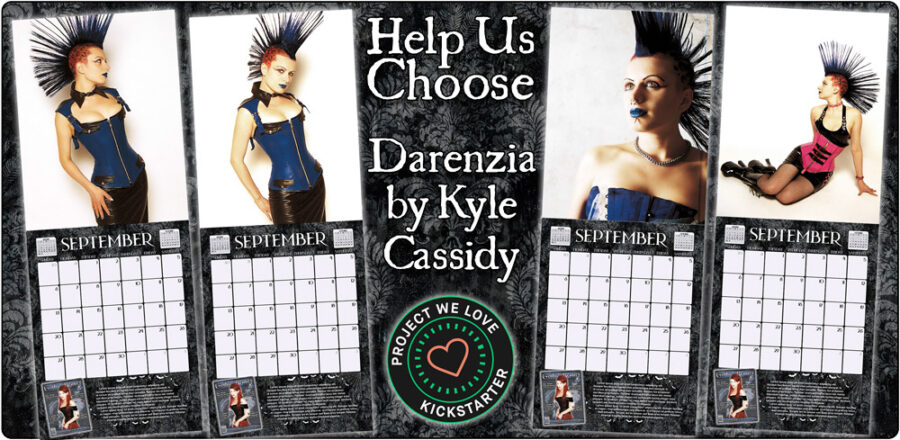
Kyle Cassidy is probably best known for his work which is documentarian but sympathetic to his subjects and he also creates more dark and fantastical imagery. His most recent book, This is Only Earth, My Dear: Images by Trillian Stars and Kyle Cassidy with poems by Elizabeth Siddal, features the more fantastical side of his work and is an “ode to the forgotten Victorian poet Elizabeth Eleanor Siddal.” He and Trillian Stars have also collaborated on two movies she starred in, both based on Ibsen plays. One of his more documentarian books This Is What a Librarian Looks Like: A Celebration of Libraries, Communities, and Access to Information was initially launched on Kickstarter and was re-released this year in a Kindle edition. His work has appeared in over a dozen books, including more whimsical tomes like his collaborations with Joan of Dark Lopapeysa, about viking sweaters, and Geek Knits, which featured geek luminaries modeling knitwear. The latter included U.S. Womens’s Chess Champion Jen Shahade, the guys from Mythbusters, George R. R. Martin, and John Carpenter. Kyle Cassidy has also shot album covers for John Carpenter, Ego Likeness, and Andy Delany from Rubicon. 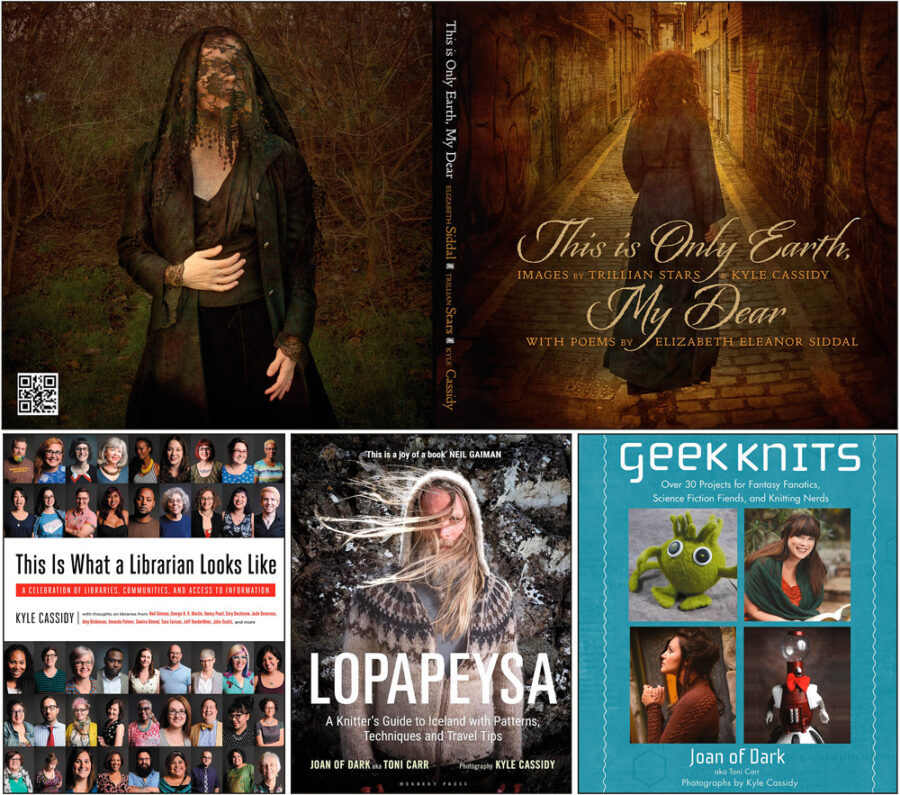 Kyle Cassidy was the first photographer to shoot a Style series for Gothic Beauty Magazine. The magazine did not even have a format for this, but Kyle Cassidy’s work was so interesting that the magazine created a whole section specifically to publish him in. He photographed fashions by MayFaire Moon, Catherine Coatney, DivaLuxe, FyreDraque, Ritual Designs, Stormy Leather, Morbid Threads, Tripp, Renee Masoomian, Nocturnalia, Fashion Crimes, and more, including pulling clothes from early Hot Topic. Models he collaborated with included Feisty Diva, Jennifer “Ayria” Parkin, Nicki Jane, Antipathy, and of course Darenzia.
Kyle Cassidy was the first photographer to shoot a Style series for Gothic Beauty Magazine. The magazine did not even have a format for this, but Kyle Cassidy’s work was so interesting that the magazine created a whole section specifically to publish him in. He photographed fashions by MayFaire Moon, Catherine Coatney, DivaLuxe, FyreDraque, Ritual Designs, Stormy Leather, Morbid Threads, Tripp, Renee Masoomian, Nocturnalia, Fashion Crimes, and more, including pulling clothes from early Hot Topic. Models he collaborated with included Feisty Diva, Jennifer “Ayria” Parkin, Nicki Jane, Antipathy, and of course Darenzia.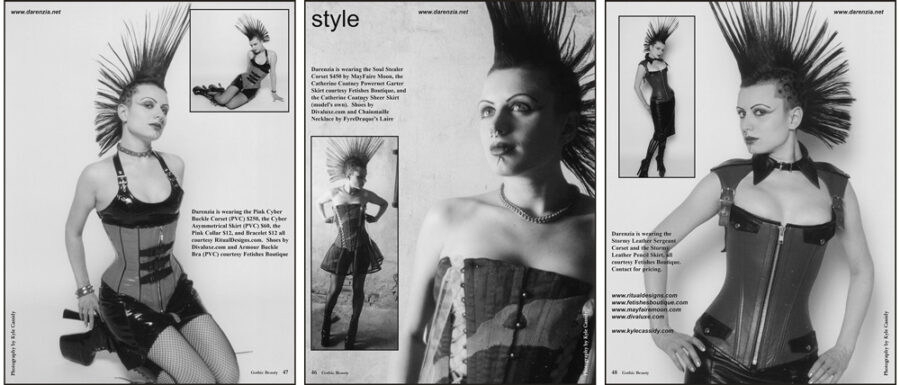 We are thinking of including one of his photos created with Darenzia in the retrospective calendar currently funding on Kickstarter. If you pledge the Gothic Beauty Kickstarter project, you can help curate which images we publish. I am very excited about getting to interview such icons of our community. Excerpts of this interview series will be included in the Gothic Beauty 25 Year Reunion of Original Artists – Calendar Project, but I wanted to share the full-length interviews as well.
We are thinking of including one of his photos created with Darenzia in the retrospective calendar currently funding on Kickstarter. If you pledge the Gothic Beauty Kickstarter project, you can help curate which images we publish. I am very excited about getting to interview such icons of our community. Excerpts of this interview series will be included in the Gothic Beauty 25 Year Reunion of Original Artists – Calendar Project, but I wanted to share the full-length interviews as well.
BTS: How did this particular shoot with Darenzia for Gothic Beauty Magazine 7 come together and what was the shoot day like? Anything you’d like to share about the location, how the collaboration went, what it was like working with your collaborators, anything extra you had to do to make the shoot happen? As you are remastering these images for this project, what was the post-processing like then and how has your process changed/evolved since then?
Philly had an extremely robust goth scene, thanks to Patrick Rodgers, a local record store owner — and he tells this story really well himself — who in 1997 decided that he’d really love to see the Sisters of Mercy get back together and do a show because he’d never seen them. And he realized that there was some amount of money for which the Sisters of Mercy would get back together and come play a gig at his house and he realized that whatever amount of money that was, he didn’t have it, but he did have lots of people coming into this goth record store — which was called Digital Ferret — and so he got this idea to essentially pool everybody’s money together, put it in a big bag with dollar signs on it, and call the Sisters of Mercy. And that culminated in the band reuniting and playing Philly in 1997 and after that, Patrick decided that he could divide his time between running a record store and doing concert promotion. So he started a quarterly event called Dracula’s Ball which was a HUUUUGE goth party with several bands and then the rest of the year, he ran a goth club night in a warehouse called Shampoo — goth night was on a Wednesday and that place would have a thousand people in it every Wednesday. I loved that place, it reminded me a lot of the Limelight in New York a) because it was the sort of place that you’d see in a movie with women dancing on boxes and dudes in spiky jackets and eight inch platform boots , and b) because it had maybe a dozen rooms, some of which were small with velvet curtains and it would be quiet, and some would have DJ’s playing German industrial or whatever. So Patrick single-handedly created this enormous Goth Scene which spun off lots of other things because you had all these people who were seeing each other fifty-six times a year all decked out.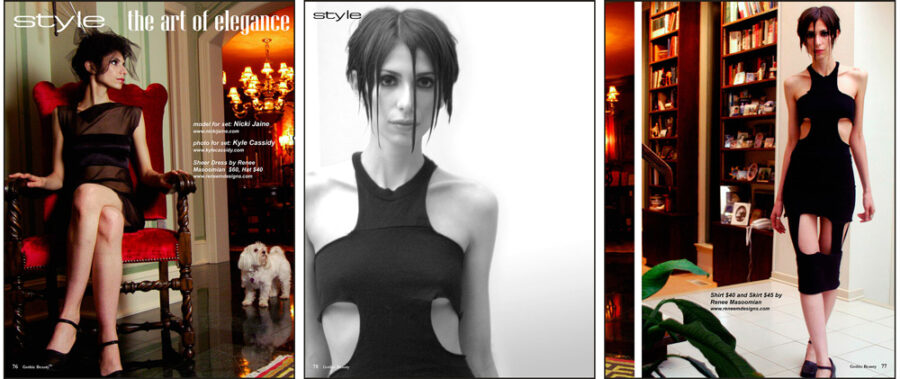
So, because of that, I knew all these models. And when Gothic Beauty came out in … 2000 maybe, and I found it at Patricks’ record store — I wanted to be in it. At the time, Fred Berger’s magazine Propaganda was the only real goth magazine out there, and it had a particular aesthetic — Lots of waify young men in stern Eastern European military uniforms who looked like they’d just been bitten by vampires — So I’m pretty sure I submitted to Gothic Beauty #2, and 3, and 4 … and I kept getting turned down. I had a kind of un-clean aesthetic, lots of shadows. And so I was studying those early issues trying to figure out what Steven Holliday would accept. There was a lot of clean-white aesthetic that showed off the fashion. And back then — I don’t know how it is now — photographers were responsible for everything, it was all on spec, so you’d contact a designer, you’d contact a model, you’d shoot photos, and the magazine would either take it or reject it.
Darenzia was dating my housemate at the time, so she was around. I think we got the corsets directly from Alternative Meat Fetish — I think that’s what she was wearing in the first shoot, and the ones with the ribbons were from Mayfaire Moon. I think I shot her twice for GB, the second time I remember at one point she was wearing a hobble skirt and platform shoes and she literally had to be picked up and moved from place to place like a log.
But the first time she had the mohawk and maybe an hour was getting her hair up in the mohawk, we shot in my studio. On film. I shot with, I think, a Nikon d100 and a Yashicamat 124g medium format. And then we went out to lunch at a restaurant. West Philly has always been pretty alt but that mohawk was spectacular. I remember we wanted to shoot something else the next day so she had to sleep on her side so we wouldn’t have to redo the hair and it held up pretty well. I remember part of it flopping over the next morning and thinking that still looked pretty good. We did some touchups and and another shoot. We were just goofing off the second time, but we did a photo that day called “punk rock divorce” which went viral before “viral” was actually a thing. Sometimes you never know what people are going to like. And that’s really the whole thing, isn’t it? For anybody doing something that depends on other people liking it in order to keep doing it. Sometimes it’s the thing you don’t spend any time and effort on that’s the thing that everybody likes. 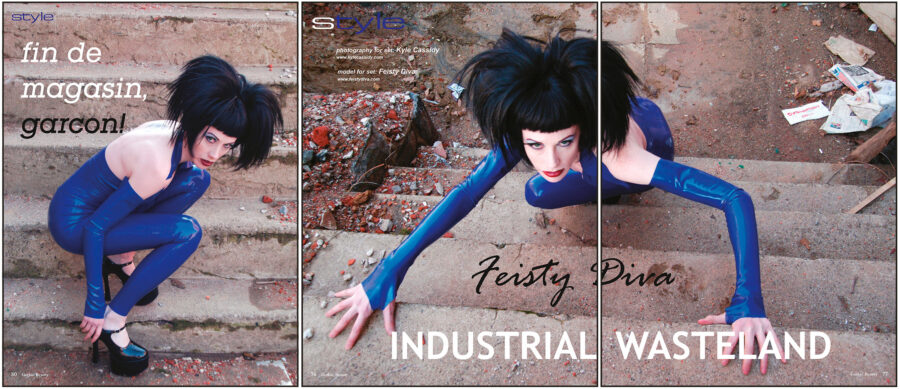 As far as photography in 2002 vs photography now, I realize going back to those images just how annoying and clunky film photography is. The scans of those images, which were the best they could reasonably do at the time are terrible and it really shows off all the flaws of the medium. Ugh. I have a romantic memory of the darkroom but it’s not really anything I want to go back to for any practical reason.
As far as photography in 2002 vs photography now, I realize going back to those images just how annoying and clunky film photography is. The scans of those images, which were the best they could reasonably do at the time are terrible and it really shows off all the flaws of the medium. Ugh. I have a romantic memory of the darkroom but it’s not really anything I want to go back to for any practical reason.
Given that your work helped define the 2000’s gothic aesthetic, what are your thoughts on the ways the culture and its art/style have evolved?
I remember thinking at the time that I could go to New York or L.A. and be a cog in the great machine of fashion, or I could stay where I was and be influential in a niche and I’m glad I stayed. I’m still really drawn to the aesthetic and I love how it’s evolved and I love how it’s peeked out into the mainstream — thinking of Helen Mirran in Winchester and the Underworld movies and The Crow. And part of it has been my own evolution. Like, how do you grow old goth? Since the culture is new it’s one of those questions that didn’t have an answer. I’m Gen X and we had literally never seen a rock-star grow old. When Gothic Beauty came out, Mick Jagger was 56, David Bowie was 53, Ozzy was 51. It was all a mystery. I knew that I never wanted to be the 60 year old guy in the top hat and the cane in the back of the goth club. So figuring out what I was going to wear and act and whatever has been a big part of that evolution.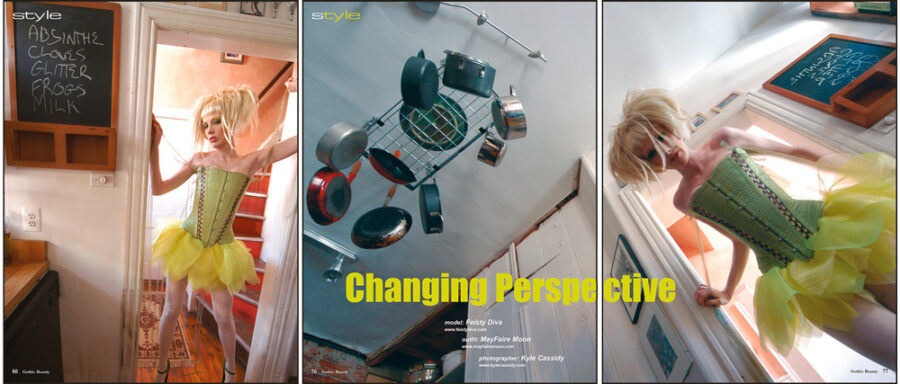 It seems to me that goth as its own thing has really been subsumed by a lot of the other genres, EBM, techno, industrial, synthwave. So the really pure Goth which I tend to think of as the Empire Hideous, and the Fields of the Nephilim, and the first few Sisters of Mercy albums doesn’t seem to really exist as a stand-alone genre to me anymore and I don’t see a clusters of 20-somethings in leather and black lace wandering through the art museum the way I used to — though I look forward to being proven wrong reading the next issue of Gothic Beauty — and the fashion has evolved. You can get more mass produced things now, fast-goth-fashion from China is real — Kambriel will still make you a cape, but the market is flooded
It seems to me that goth as its own thing has really been subsumed by a lot of the other genres, EBM, techno, industrial, synthwave. So the really pure Goth which I tend to think of as the Empire Hideous, and the Fields of the Nephilim, and the first few Sisters of Mercy albums doesn’t seem to really exist as a stand-alone genre to me anymore and I don’t see a clusters of 20-somethings in leather and black lace wandering through the art museum the way I used to — though I look forward to being proven wrong reading the next issue of Gothic Beauty — and the fashion has evolved. You can get more mass produced things now, fast-goth-fashion from China is real — Kambriel will still make you a cape, but the market is flooded
Obviously your work from this time period is iconic, but, from your perspective, where were you at in your career at the time?
It was slightly north of nowhere headed somewhere. By then I’d had a lot of art exhibits but was still creeping along. I’m pretty sure I felt famous but not famous enough. If that makes any sense. There were a few Philly scene photographers who’d gotten together and put out a book of their photos and I thought that was the height of success. I was spending a lot of days between inspiration, motivation, opportunity and jealousy — those were the four engines driving everything and that’s not a terrible place to be, really.
www.kylecassidy.com
Bluesky: @kylecassidy.bsky.social
The Gothic Beauty reunion retrospective Project is on Kickstarter until December 11.



